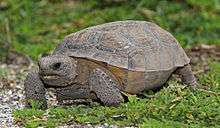Gopherus
| Gopherus | |
|---|---|
 | |
| Gopher tortoise, Gopherus polyphemus | |
| Scientific classification | |
| Kingdom: | Animalia |
| Phylum: | Chordata |
| Class: | Sauropsida |
| Order: | Testudines |
| Suborder: | Cryptodira |
| Superfamily: | Testudinoidea |
| Family: | Testudinidae |
| Genus: | Gopherus Rafinesque, 1832 |
| Species | |
| |
Gopherus is a genus of fossorial tortoises commonly referred to as gopher tortoises. The gopher tortoise is grouped with land tortoises that originated 60 million years ago, in North America. A genetic study has shown that their closest relatives are in the Asian genus Manouria.[1] The gopher tortoises live in the southern United States from California's Mojave Desert across to Florida, and in parts of northern Mexico. Gopher tortoises are so named because of their ability to dig large, deep burrows; those of the Gopher tortoise can be up to 40 feet (12 m) in length and 10 feet (3.0 m) in depth.[2] These burrows are used by a variety of other species, including mammals, other reptiles, amphibians, and birds.[3] Gopher tortoises are 20–50 cm (7.9–19.7 in) in length, depending on the species.[4] All five species are found in xeric habitats.
Diet
Gopher tortoises are mainly herbivores that feed on low growing plant life. Their diet consists mostly of grasses and legumes. Gopher tortoises are scavengers and will also feed on small berries, fruits, carrion, and excrement. Gopher tortoises are rarely seen drinking from still water. Most of the water gopher tortoises consume comes from within the food they eat.
Breeding
Gopher tortoises usually mate during the months of April and May. The female will then choose either a sunny spot nearby or a sandy mound in front of her burrow to lay between 3 and 15 eggs. The eggs then hatch from 70 to 100 days later. Once hatched the baby tortoises spend most of their time in their mother's burrow until they learn to dig their own. They do not reach maturity until they are around 10 to 15 years old. Gopher tortoises have an abbreviated mating season in early spring, when male tortoises visit the female tortoise' burrows and mate with them.[5]
Species
In July 2011, researchers decided on the basis of DNA and behavioral data that the Sonoran and Mojave populations of the desert tortoise were distinct species.[6] As such, there are currently six recognized species in the genus Gopherus:
Listed alphabetically by binomial name.[7]
- Mojave desert tortoise of Agassiz's desert tortoise Gopherus agassizii (Cooper, 1863)
- Texas tortoise Gopherus berlandieri (Agassiz, 1857)
- Bolson tortoise Gopherus flavomarginatus (Legler, 1959)
- Sonoran desert tortoise or Morafka’s desert tortoise Gopherus morafkai (Murphy et al., 2011)[6]
- Sinaloan desert tortoise or Goode's desert tortoise Gopherus evgoodei (Edwards et al., 2016)[8]
- Gopher tortoise Gopherus polyphemus (Daudin, 1802)
Members of Gopherus that became extinct in the late Pleistocene:
Conservation
Populations of all six species of Gopherus have declined dramatically. In the past, gopher tortoises were hunted for their meat, which was used in stews.[12] Currently the most significant threat to their survival is habitat destruction, but the pet trade and collisions with vehicles have also taken their toll.[4] To help decrease gopher tortoise death due to collisions with vehicles, the US Department of Transportation in Mississippi has recently placed angled fences along the road side to keep tortoise from wandering onto the highways near their habitats.[13] On November 9, 2009, the US Fish and Wildlife Service proposed rulemaking to include the Eastern Population of the Gopher tortoise, Gopherus polyphemus, in the List of Threatened Wildlife.[14]
References
- ↑ Le, M.; Raxworthy, C. J.; McCord, W. P.; Mertz, L. (2006-05-05). "A molecular phylogeny of tortoises (Testudines: Testudinidae) based on mitochondrial and nuclear genes". Molecular Phylogenetics and Evolution. 40 (2): 517–531. PMID 16678445. doi:10.1016/j.ympev.2006.03.003.
- ↑ "About The Gopher tortoise". Gopher Tortoise Council. Archived from the original on 2009-09-01. Retrieved 2009-07-03.
- ↑ Fergus, Charles (2007). Turtles. Stackpole Books. pp. 22–24. ISBN 978-0-8117-3420-2.
- 1 2 Franklin, Carl J. (2007). Turtles: An Extraordinary Natural History 245 Million Years in the Making. MBI Publishing Company. pp. 129–131. ISBN 978-0-7603-2981-8.
- ↑ Landers, L.J., Garner, J.A. & McRae, W.A. (1980). Reproduction on Gopher Tortoises in Southwestern Georgia, Herpetological, 36, 353-361.
- 1 2 US Geological Survey
- ↑ Gopherus, The Reptile Database
- ↑ Edwards T, Karl AE, Vaughn M, Rosen PC, Torres CM, Murphy RW, Taylor; Karl, Alice; Vaughn, Mercy; Rosen, Philipe; Meléndes Torres, Christina; Murphy, Robert W. (2016). "The desert tortoise trichotomy: Mexico hosts a third, new sister-species of tortoise in the Gopherus morafkai–G. agassizii group.". ZooKeys. 562: 131–158. PMC 4768471
 . PMID 27006625. doi:10.3897/zookeys.562.6124.
. PMID 27006625. doi:10.3897/zookeys.562.6124. - ↑ Reynoso, Víctor-Hugo; Montellano-Ballesteros, Marisol (2004-01-01). "A New Giant Turtle of the Genus "Gopherus" (Chelonia: Testudinidae) from the Pleistocene of Tamaulipas, México, and a Review of the Phylogeny and Biogeography of Gopher Tortoises". Journal of Vertebrate Paleontology. 24 (4): 822–837. JSTOR 4524778. doi:10.1671/0272-4634(2004)024[0822:angtot]2.0.co;2.
- ↑ Rostal, David C.; McCoy, Earl D.; Mushinsky, Henry R. (2014-06-13). Biology and Conservation of North American Tortoises. JHU Press. ISBN 9781421413778.
- ↑ "Ecological history and latent conservation potential: large and giant tortoises as a model for taxon substitutions" (PDF).
- ↑ "Gopher Tortoise Stew", in: Recipes from Another Time: Savor the flavor of old St. Augustine and try a couple of these original recipes. Smithsonian magazine, October 2001
- ↑ "Fence with an "angle" protects gopher tortoises". US Department of Transportation. 2003-04-25. Retrieved 2010-04-18.
- ↑ "Federal Register, 50 CFR Part 17" (PDF). 74 (215). National Archives and Records Administration. 2009-11-09. Retrieved 2009-11-13.
External links
| Wikimedia Commons has media related to Gopherus. |
| Wikispecies has information related to: Gopherus |
